Big Canyon Steelhead Habitat Restoration
Purpose: To enhance steelhead trout natural production by improving salmonid spawning and rearing habitat in Big Canyon Creek Watershed.
Special Emphasis: Agricultural lands with existing land-use practices which are adversely impacting fish habitat with the goal of:
- Improving watershed hydrology
- Increasing multi-layered riparian vegetation
- Reducing impacts from sediment, nutrients, and bacteria which are adversely impacting water quality
- Focusing on riparian areas
Big Canyon Creek is located in North Central Idaho and is within Nez Perce and Lewis counties, Idaho. The National Marine Fisheries Service in their Recovery Plan identifies Big Canyon Creek as critical steelhead habitat within the lower Clearwater River.
Steelhead habitat restoration efforts have been on-going since 1999. The District received funding from the Bonneville Power Administration from 1999 through 2009. From 2009 through 2013 restoration efforts were funded through the Idaho Governor’s Office of Species Conservation. The District plans to apply for additional funding to address actions identified in the 2009 Big Canyon Creek Ecological Restoration Plan.
Big Canyon Creek Steelhead Habitat Restoration Plan
This planning effort was a joint project between the Nez Perce Soil and Water Conservation District (NPSWCD) and the Nez Perce Tribe Department of Fisheries Resources Management Watershed Division (NPT-DFRM-Watershed). The document’s purpose is to guide steelhead habitat restoration activities within the Big Canyon Creek watershed for the period of 2008-2018.
Big Canyon Creek Ecological Restoration Strategy - 2009
The Bonneville Power Administration provided funding for restoration activites from 1999 to 2009. This project, entitle Restoring Anadromous Fish Habitat in the Big Canyon Creek watershed ended in the spring of 2009.
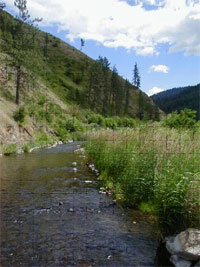 The purpose of this project is to enhance, protect, and/or restore steelhead habitat in the Big Canyon Creek watershed. Habitat features needing restoration include both spawning and juvenile fish rearing components.
The purpose of this project is to enhance, protect, and/or restore steelhead habitat in the Big Canyon Creek watershed. Habitat features needing restoration include both spawning and juvenile fish rearing components.
The District provided funding to land owners to install projects to improve steelhead habitat through improving water quality, lowering stream temperatures, creating and/or improving riparian areas, and increasing water retention in the watershed.
The project was funded by the Idaho Governor’s Office of Species Conservation through the Pacific Coastal Salmon Recovery Fund.
Big Canyon Creek historically provided quality spawning and rearing habitat for A-run wild summer steelhead in the Clearwater River system. However, high stream temperatures, excessive sediment and nutrient loads, low summer stream flows, and lack of stream cover caused anadromous fish habitat constraints in the creek. The primary sources of these nonpoint source pollution and habitat degradations are attributed to agricultural, livestock, and forestry practices. Addressing these problems is made more complex due to the large percentage of privately owned lands in the watershed.
This proposal’s goals include installation of upland and cropland erosion controls, riparian plantings to lower water temperatures, channel modifications, and measures to limit rural road runoff. Specific goals are outlined in the Big Canyon Creek Ecological Restoration Strategy - 2009.
Phase I of this project began in 2009 and concluded in 2013.
Accomplishments
The Nez Perce Soil and Water Conservation District (NPSWCD) received funds from a Pacific Coast Salmon Recovery Fund (PCSRF) project for the period January 2010 through January 2013. Funds were used by the District to install three livestock water developments, 3,025 linear feet of fence, three erosion control practices, 1.3 acres of wetland enhancement, 0.78 miles of road improvements, 81 acres of pest management, 10.9 acres riparian plantings, 30.22 acres of upland plantings, and 20 biocontrol releases.
Cold Springs Creek Riparian Restoration Area
Located along Cold Springs Creek, in the headwaters of Big Canyon Creek this project restores approximately 30 acres of riparian areas. Project work includes vegetative plantings to control sheet/rill erosion and reduce sediment delivered to the stream. Project work began in 2010 and was concluded the fall of 2012.
 | |
| Figure 1. Cold Springs Restoration Concept Map |
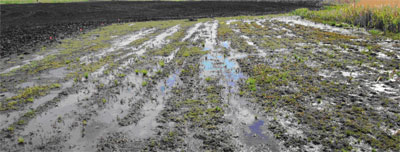 |
| Figure 2. Cold Springs Restoration Wetland Planting. Photo Jes Erling, Nez Perce Soil and Water Conservation District. 2013. |
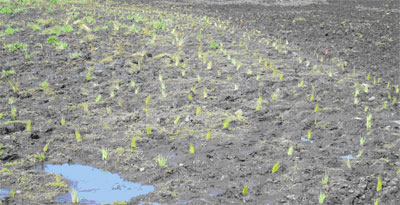 |
| Figure 3. Cold Springs Restoration Wetland Planting. Photo Jes Erling, Nez Perce Soil and Water Conservation District |
Livestock watering systems
Three livestock watering systems were installed. These systems provided an off-stream source of water and removed livestock from the stream corridor. The systems included a combination of underground pipe, storage cisterns and troughs.
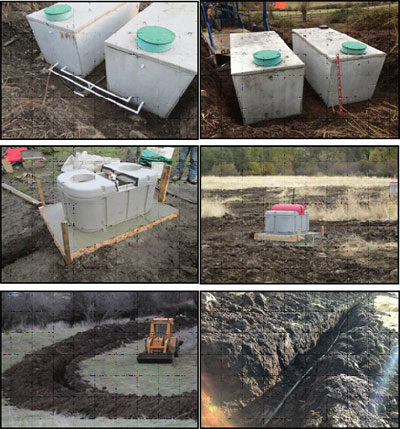 |
| Figure 4. Livestock watering system components. Photo: Jes Erling, Nez Perce Soil and Water Conservation District. 2012. |
Vegetative Plantings
To reduce sediment delivery, improve flow and increase stream habitat shading in Big Canyon Creek, the District planted 10.9 acres of riparian plantings and 30.22 acres of upland plantings using native plant species.
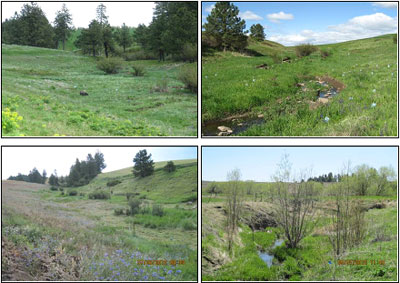 |
| Figure 5. Riparian plantings. Photo Nikki Lane. Nez Perce Soil and Water Cosnervation District. |
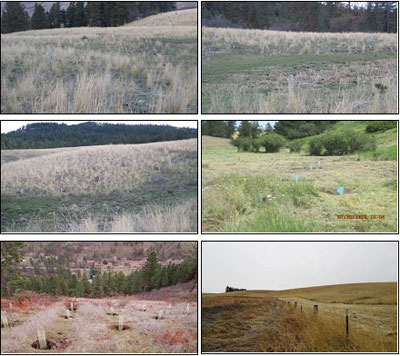 |
| Figure 6. Upland vegetation plantings. |
Fencing
In order to protect wetlands/riparian areas, District staff worked with landowners to install 3,025 linear feet of fence at locations previously identified through District stream inventory and conservation planning
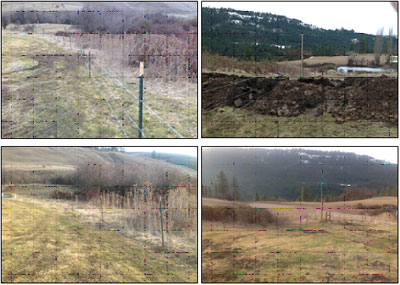 |
| Figure 7. Fencing installation stages. Photo: Jes Erling, Nez Perce Soil and Water Conservation District. 2012. |
Bio-Control Releases
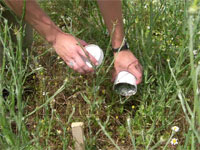
Bio-control is a method that uses insects such as weevils and moths to control noxious weeds. These insects’ larvae feed on developing weed seeds and reduces seed production. Using Nez Perce Tribe Bio Control and USDA-Forest Service protocols, District field technicians released bio-control agents within the Big Canyon Creek watershed for the control of yellow starthistle and spotted knapweed. Three hundred insects were released at 20 different sites.